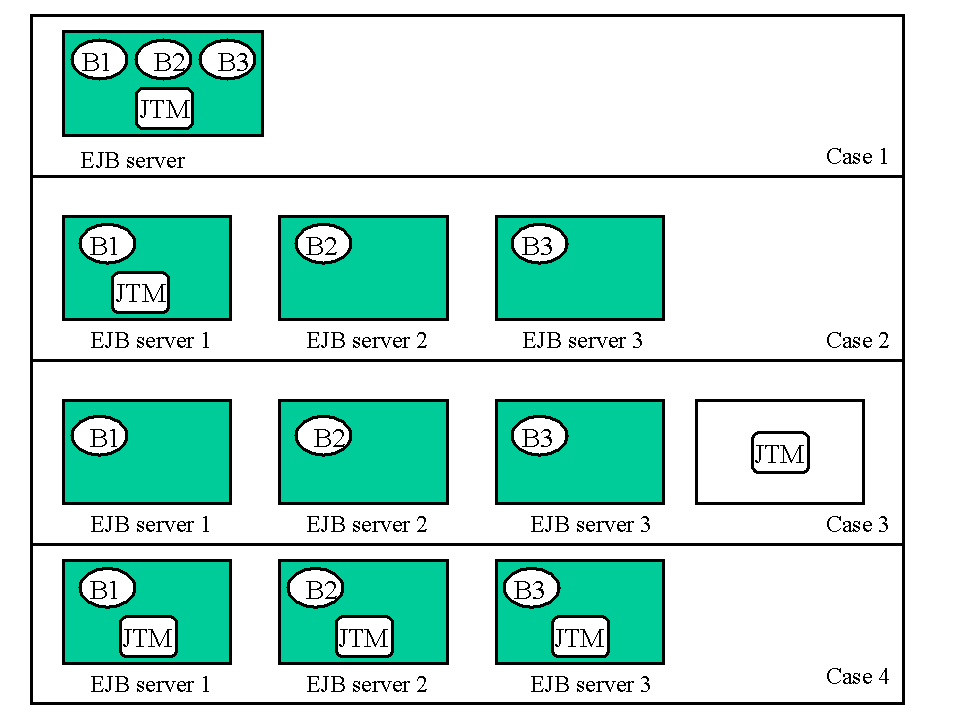
The target audience for this guide is the Enterprise Bean provider, i.e. the person in charge of developing the software components on the server side. It describes how to define the transactional behaviour of an EJB application.
The content of this guide is the following:
For container-managed transaction management, the transactional behaviour of an enterprise bean is defined at configuration time and is part of the assembly-descriptor element of the standard deployment descriptor. It is possible to define a common behaviour for all the methods of the bean, or to define the behaviour at the method level. This is done by specifying a transactional attribute, which can be one of the following:
| Transaction Attribute | Client transaction | Transaction associated with enterprise Bean's method |
|---|---|---|
| NotSupported | -
T1 |
-
- |
| Required | -
T1 |
T2
T1 |
| RequiresNew | -
T1 |
T2
T2 |
| Mandatory | -
T1 |
error
T1 |
| Supports | -
T1 |
-
T1 |
| Never | -
T1 |
-
error |
In the deployment descriptor, the specification of the transactional attributes appears in the assembly-descriptor as follows:
<assembly-descriptor>
<container-transaction>
<method>
<ejb-name>AccountImpl</ejb-name>
<method-name>*</method-name>
</method>
<trans-attribute>Supports</trans-attribute>
</container-transaction>
<container-transaction>
<method>
<ejb-name>AccountImpl</ejb-name>
<method-name>getBalance</method-name>
</method>
<trans-attribute>Required</trans-attribute>
</container-transaction>
<container-transaction>
<method>
<ejb-name>AccountImpl</ejb-name>
<method-name>setBalance</method-name>
</method>
<trans-attribute>Mandatory</trans-attribute>
</container-transaction>
</assembly-descriptor>
In this example, for all methods of the AccountImpl bean which are not explicitly specified in a container-transaction element, the default transactional attribute is Supports (defined at the bean-level), and the transactional attributes are Required and Mandatory (defined at the method-name level) for the methods getBalance and setBalance respectively.
A bean that manages its transactions itself must set the transaction-type element in its standard deployment descriptor to:
<transaction-type>Bean</transaction-type>
To demarcate the transaction boundaries in a bean with bean-managed transactions, the bean programmer should use the javax.transaction.UserTransaction interface, which is defined on an EJB server object that may be obtained using the EJBContext.getUserTransaction() method (the SessionContext object or the EntityContext object depending on whether the method is defined on a session or on an entity bean). The following example shows a session bean method "doTxJob" demarcating the transaction boundaries; the UserTransaction object is obtained from the sessionContext object, which should have been initialized in the setSessionContext method (refer to the example of the session bean).
public void doTxJob() throws RemoteException {
UserTransaction ut = sessionContext.getUserTransaction();
ut.begin();
... // transactional operations
ut.commit();
}
Another way to do this is to use JNDI and to retrieve UserTransaction with the name java:comp/UserTransaction in the initial context.
As explained in the previous section, the transactional behaviour of an application can be defined in a declarative way or coded in the bean and/or the client itself (transaction boundaries demarcation). In any case, the distribution aspects of the transactions are completely transparent to the bean provider and to the application assembler. This means that a transaction may involve beans located on several JOnAS servers and that the platform itself will handle management of the global transaction. It will perform the two-phase commit protocol between the different servers, and the bean programmer need do nothing.
Once the beans have been developed and the application has been assembled, it is possible for the deployer and for the administrator to configure the distribution of the different beans on one or several machines, and within one or several JOnAS servers. This can be done without impacting either the beans code or their deployment descriptors. The distributed configuration is specified at launch time. In the environment properties of an EJB server, the following can be specified:
To achieve this goal, two properties must be set in the jonas.properties file, jonas.service.ejb.descriptors and jonas.service.jtm.remote. The first one lists the beans that will be handled on this server (by specifying the name of their ejb-jar files), and the second one sets the Java Transaction Monitor (JTM) launching mode:
Example:
jonas.service.ejb.descriptors Bean1.jar, Bean2.jar
jonas.service.jtm.remote false
The Java Transaction Monitor can run outside any EJB server, in which case it can be launched in a stand-alone mode using the following command:
TMServer
Using these configuration facilities, it is possible to adapt the beans distribution to the resources (cpu and data) location, for optimizing performance.
The following figure illustrates four cases of distribution configuration for three beans.

These different configuration cases may be obtained by launching the JOnAS servers and eventually the JTM (case 3) with the adequate properties. The rational when choosing one of these configurations is resources location and load balancing. However, consider the following pointers: